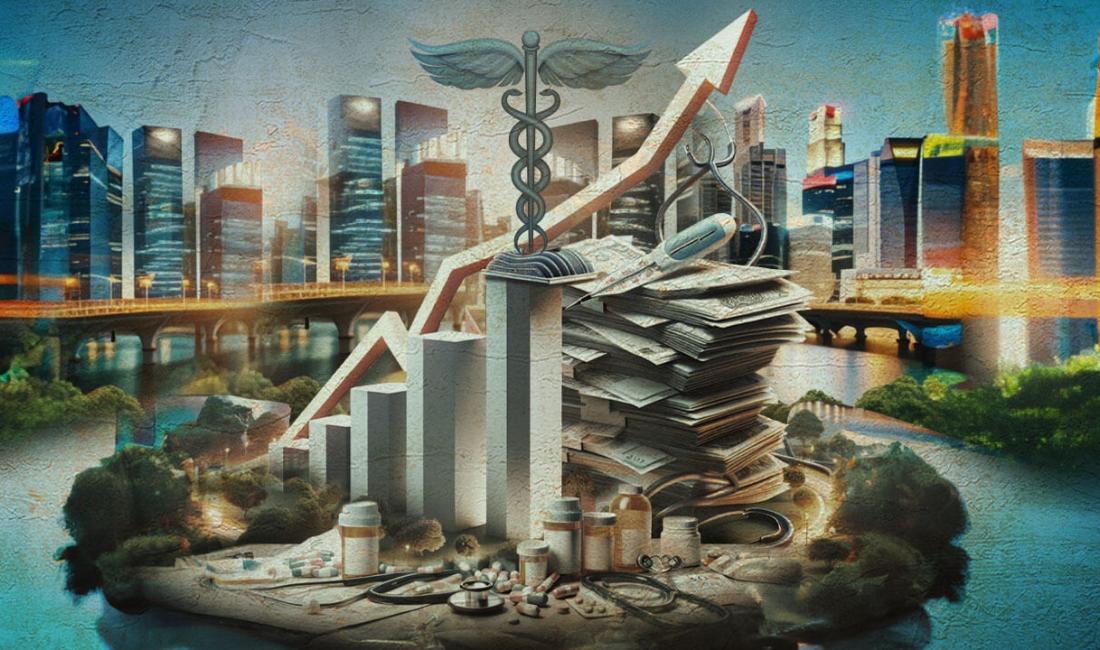Health care and a lack of democracy.
This story was originally written for and published by Asia Democracy Chronicles. Illustration credit: Asia Democray Chronicles.
Last February, a family posted online a part of what they spent on having three babies in succession beginning 2019. According to the family, they saw their medical bill rise for each infant, including one component that cost them SGD 13.80 (US$10.22) for the first child, SGD 14.00 (US$10.37) for the second, and SGD 14.80 (US$10.96) for the third.
That may not seem much – one Singapore dollar has a current exchange rate of 74 U.S. cents. But between Baby No. 1 and Baby No. 3, the cost for the same item rose by more than six percent. And here’s what that fee was for: a mere referral letter from a polyclinic to one of Singapore’s public hospitals, so that the missive’s bearer could receive subsidized treatment.
The family’s post quickly went viral on social media. In any other first-world country, such a viral post that touched on rising healthcare costs would have been picked up by the local media, and the matter possibly debated over in parliament.
But in Singapore, even opposition politicians failed to question the ruling party about the issue. In the meantime, the government seems to be gearing up for an increase in the premiums of mandatory health insurance for Singaporean citizens, as part of its solution to the rising healthcare costs.
That’s the bad news, at least for the scores of hard-up Singaporeans – and yes, there are many. The worse news is that there is no transparency and accountability regarding how much is being collected through the compulsory healthcare savings and insurance programs, how the government has been investing the monies and how much it has earned in return, and what exactly it is giving back to the people.
This is important because the amounts the government demands that citizens fork over for the state to safekeep and grow are substantial. Yet Singaporeans in need of healthcare usually end up feeling they are not getting back nearly as much as they had put in the state coffers.
That feeling has been intensifying in the last few years. In fact, it is among the reasons why Singapore’s birth rate has hit an all-time low of 0.97 births per woman. Although Singaporeans in their 20s say they want to have children, many of them cite pregnancy costs, including giving birth, as among the deterrent factors.
A nurse at one of the public polyclinics, which Singaporeans use for consults and primary care, says, “Every day there are people coming to tell me that they are shocked at the increase in bills. Some will ask me how come they were not being informed of the increase; some will scold me that I’m cheating them of their money. But I’m not the person taking the money and my salary didn’t increase, too. What I can do is to send them for financial counseling or to direct them to social workers to help them out of the situation.”
Ranks and reality
As in most matters, Singapore on the surface looks like it is doing well, health-wise. According to the data portal Statista, Singapore was number one among 195 countries in 2023 in terms of its people’s health and quality of its health system.
Its most recent ranking (2021) of countries based on effective universal health coverage (UHC), meanwhile, had Singapore in the still respectable fourth slot, behind Canada, Iceland, and South Korea.
In putting the UHC index together, Statista says that it “considers to which extent health services cover the health care needs of a population and how they improve health outcomes.”
Outsiders often assume that a wealthy country like Singapore has citizens who enjoy universal health coverage paid for by the government. But the reality is that money comes out of Singaporeans’ pocket to cover every step of their health-seeking journey, and for all kinds of medical procedures and illnesses. And this is after they have already put in sums into the compulsory health savings and insurance programs.
Singaporeans who work must make contributions to the Central Provident Fund (CPF), which is split into three accounts: Ordinary Account (OA), MediSave Account (MA), and Special Account (SA). A Singaporean who reaches 55 years old also has to have a Retirement Account (RA).
There are mandatory health insurance schemes as well: MediShield Life, which is supposed to help Singaporeans cover large hospital expenses (smaller ones are supposed to be covered by MediSave), and ElderShield, which the government says is for “long-term care” and especially meant for severe disabilities among the elderly.
Every Singaporean employee contributes eight to 10.5 percent (depending on age group) of his or her monthly salary to a personal MediSave account. For Medishield, the annual premium can reach as high as SGD 2,000 (US$1,481.60), sometimes even more. The ElderShield annual premium is currently SGD 200 (US$148.16), but it increases every year.
Eighty percent of all hospital beds in Singapore are in what most locals and outsiders alike call “public” hospitals, or the state-owned and operated healthcare facilities that the government says have been “restructured” and are run as private companies. These facilities offer subsidized services, but only if one presents a referral from a state polyclinic.
Just trying to secure an appointment at a polyclinic, however, can be so challenging that some Singaporeans simply give up and go to hospital without a referral. Then they brace themselves for the unsubsidized bill. Then again, showing up with a referral at a public hospital still means bracing oneself, but for conditions that are less than ideal.
To ensure that one gets what the government calls a “subsidized bill” in a public hospital, the referral-letter bearer must stay in either a B2 or C ward – also known as the lower-end wards with shared facilities and no air-conditioning, unlike the A and B1 wards.
Many of those who have stayed in these shared facilities have brought up the issue of hygiene (or lack thereof) there, as well as the significant distance of toilets from the beds, which could be daunting for someone just out of surgery or attached to a drip. It’s therefore no surprise that many Singaporeans think that after all they had put into the state savings schemes and insurance, they are being shortchanged.
“Patients will have to walk from their beds to the toilets, including those who are having ‘fall risk’ labels on them,” admits a public hospital doctor. “We do have shared wards with toilets that are closer to the patients or private wards with toilets just beside the patients, but they will have to pay more. Nonetheless, with the increase in healthcare costs in Singapore and as reported in the news, there are more people downgrading rather than upgrading.”
“As a doctor,” he continues, “I can give them painkillers if they are feeling (too much) pain while walking, or simply put a pee bag on them. But I must remember my job is a doctor, so they should recover to walk rather than choosing the pee bag and later go through the whole painful removal process again. As for the system of pricing, it’s up to the financial department. Having the toilets being so far away is also not just the patients’ problems but for us doctors and the nurses who need to use the toilet, too.”
Little public accounting
Faced with such conditions, many Singaporeans have also been wondering what the government has been doing with all those sums in MediSave and MediShield Life. No one really knows, because the government isn’t telling. But it has coughed up some numbers about MediSave and the insurance schemes, as well as Medifund, an endowment fund meant to help out those who have already exhausted their MediSave and MediShield limits.
In 2014, the government said the monies in the MediSave accounts came to a total of SGD 70.5 billion (US$ 52 billion), while Singaporeans had withdrawn a total of SGD 853 million (US$631.8 billion) that year. The health budget for that year was SGD 7 billion (US$ 5.1 billion).
By 2021, the MediSave balance had reached SGD 117.6 billion (US$87 billion), with the withdrawals totaling SGD 1.115 billion (US$825 million). The 2021 health budget was SGD 18.43 billion (US$13.6 billion). In 2023, it was down to less than SGD 17 billion (US$12.5 billion), but it went up again this year to almost SGD 19 billion (US$14 billion).
As for out-of-pocket expenditure for health in Singapore, this went down from 33.3 percent in 2014 to 18.97 percent in 2020, based on World Health Organization data.
Why then are Singaporeans still feeling sick in the pocket whenever they need medical care? According to financial consultant Abram Lim, it’s largely because healthcare costs have simply outpaced living costs. Minister for Health Ong Ye Kyung says that the rising healthcare costs are even upsetting set assumptions for MediShield Life coverage.
In a speech last March, Ong said that MediShield had been designed “such that nine out of 10 subsidized bills are adequately covered. What remains are relatively small and expected co-payments, which can be paid from MediSave.”
“However,” he said, “this nine in 10 benchmark is being eroded, because the size of hospital bills is getting larger and larger. Bill sizes have grown by five percent annually in public hospitals, and by seven percent annually in private hospitals, over the last few years. As a result, the proportion of subsidized bills adequately covered by MediShield Life has come down to around eight out of 10, and is expected to slip further.”
“The practical impact is that subsidized patients are seeing hospital bills that are unexpectedly large,” Ong continued. “And after subsidy and MediShield Life, there is still a substantial out-of-pocket component left. This is when higher healthcare costs really start to bite.”
Ong added that the government is looking at raising claim limits and enhancing outpatient treatment coverage. He also said that increasing premiums were on the table, although he added that the government “will do the necessary to ensure that as far as possible, premiums can be paid fully by MediSave.”
A life insurance agent says that Singaporeans will nevertheless end up in financial pain. He says: “The last time (MediShield Life) was reviewed was in 2020, when premiums went up by 25 percent on average. So these proposed changes that will better protect subsidized patients against major health episodes simply mean MediShield Life premiums will inevitably go up.”
“Yet,” says the agent, “it does not necessarily mean that the government will give you protection, it may even be the other way around … So this will actually mean Singaporeans will need to pay cash and buy their own private insurance if they truly want coverage for their healthcare bills instead of getting a bill shock.”



